
What is Fringe Benefit Tax (FBT) and how it affecting your business?
Employers pay Fringe Benefits Tax on certain benefits they provide to their employees or associates, in addition to their salaries. FBT is distinguished from income tax and is calculated on the taxable benefit of fringe benefits. The use of a vehicle for personal purposes by an employee is a typical example that would trigger fringe benefit tax. Noticed that making a vehicle available for the use of employees or shareholders is sufficient to trigger the FBT liability, not when it is actually used.
Vehicle Type and FBT exemptions
Provision of motor vehicles for private use is generally taxable under the fringe benefit tax rules. Nevertheless, there are FBT exemptions that can be either restricted work-related travel with minor private use or specific types of vehicles that are exempt from FBT. Generally, the vehicles must be a taxi, a panel van, or a utility truck that carries a load of less than one ton, or vehicle designed to carry a load of one tonne or more, or more than eight occupants. If the vehicle is designed to carry loads less than 1 tonne, it cannot be used for passenger transport.
How much will you pay for using a business car for private use?
Businesses typically use two difference methods to calculate FBT taxes, one is operating cost method which based on actual expenses that incurred from personal usage, it can be more accurate and tax benefit on calculating the cost base, but strictly requests the logbook for at least three continuous months; another one is statutory method that is calculated based on how much the vehicle costs, as it is a straightforward method that does not require detailed records, the rate is based on a flat 20% of the car’s base value, taking into consideration how many days per year the vehicle is used privately.
For instance, if a business owns a vehicle that costs $50000 and is available for private use for a year.
(($50000*20%*FBT days)/365) which gives the base value of the FBT cost = $10000
This basically means paying 20% of a vehicle valued at $50000 on FBT ONLY!
Additionally, it is especially important if the company offers luxury cars as fringe benefits.
Can you hide FBT from ATO and audit?
The Australian Tax Office (ATO) established a national special task force specifically assessing businesses’ registration records to seek out those holding luxury cars. According to the ATO, companies that own one or more high-value vehicles are likely to be targeted for audit. Also, ATO engages high-risk employers in targeted compliance engagements based on data and analytics. The special task force was successful in identifying entities that hiding FBT from ATO, a several of fringe benefits assessments were based on this method. In consequences, most default assessments carry a 75% penalty and interest rate for 4 years.
The new electric car discounted 2022
Excitingly, from 1 July 2022, employers do not have to pay fringe benefits tax on eligible electric vehicles, that means the employers provide electric cars to employees for private use could save a huge amount of money on FBT under the new bill. The eligible vehicles are requested to meet certain criteria, such as being a zero or low emissions vehicle, and being used for the first time on or after 1 July 2022. Furthermore, it must be used by a current employee or their associates.
An example of the new bill that gives FBT saving as below:
Using the current FBT & gross-up rates, a $48,000 worth of electric car could save up to $9,385 from annual FBT liabilities.
Not only this, with this FBT exemption, salary sacrifice arrangement will provide further benefits for both employees and employers towards recruitment.

